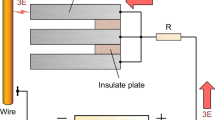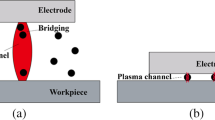Abstract
Multi-channel wire electrical discharge machining (WEDM) is widely used for slicing semiconductor materials and improving cutting rate through multi-channel discharge. However, enhancing the cutting rate of integral metal workpieces through the utilization of multi-channel WEDM remains a challenge. This paper investigated the discharge characteristics of metal workpiece using multi-channel high-speed WEDM (HSWEDM). It was discovered that due to the high conductivity of the metal workpiece, there is electrical signal coupling between each channel, which inhibits the independent discharge of each channel and severely impacts the improvement of cutting rate. To solve this problem, a new power supply with a decoupled circuit was designed, and the potential difference between adjacent channels was formed by using a current-limited resistor at each output, reducing coupling between the channels and enabling independent discharges at each channel, thereby improving the cutting rate of metal materials. The effect of current-limited resistance (Rc) on multi-channel synchronous discharges was analyzed through online acquisition of discharge signals, demonstrating that reducing the Rc can improve the discharge ratio. In the two-channel HSWEDM with the new power supply, when the Rc is reduced from 15 to 5/3 Ω, the gap voltage is increased from 31 to 64 V, the discharge ratio is increased from 0.967 to 1.566, and the increase in cutting rate was from 19.06% to 83.02%. Furthermore, when Rc is 5/2 Ω, the cutting rate was 1.660–1.971 times that of conventional power supply. Since each channel can implement independent servo control after electrical signal decoupling, the dimensional uniformity and surface topography of grooves are improved, and the thickness of the recast layer is reduced. Lastly, the new power supply was applied to the four-channel HSWEDM, resulting in a significant increase in cutting rate, which was 3.538 times higher than that of conventional power supply.















Similar content being viewed by others
References
Mouralova K, Bednar J, Benes L, Prokes T, Zahradnicek R, Fries J (2023) Mathematical models for machining optimization of Ampcoloy 35 with different thicknesses using WEDM to improve the surface properties of mold parts. Materials 16(1):100. https://doi.org/10.3390/ma16010100
Chaudhary T, Siddiquee AN, Chanda AK (2019) Effect of wire tension on different output responses during wire electric discharge machining on AISI 304 stainless steel. Def Technol 15(4):541–544. https://doi.org/10.1016/j.dt.2018.11.003
Kumar NEA, Ganesh M, Babu AS, Elakkiyadasan R (2023) Effect of Cryo-treatment of wires on machining performance of WEDM. Mater Manuf Process:1–10. https://doi.org/10.1080/10426914.2023.2217897
Zhang YM, Guo SY, Zhang Z, Huang H, Li WY, Zhang GJ, Huang Y (2019) Simulation and experimental investigations of complex thermal deformation behavior of wire electrical discharge machining of the thin-walled component of Inconel 718. J Mater Process Technol 270:306–322. https://doi.org/10.1016/j.jmatprotec.2019.02.020
Wang GL, Shi S, Zhou HC (2023) Investigation of rubber flow during tire shaping process by experiment and numerical simulations. J Appl Polym Sci 140(10). https://doi.org/10.1002/app.53607
He H, Xing Y, Wang RG, Lu YL, Zhang LQ, Li FZ (2023) Optimization design of cooling system for injection molding mold of non-pneumatic tire. Therm Sci Eng Prog 42:101866. https://doi.org/10.1016/j.tsep.2023.101866
Yue XM, Yang XD (2021) The role of discharge plasma on molten pool dynamics in EDM. J Mater Process Technol 293:117092. https://doi.org/10.1016/j.jmatprotec.2021.117092
Chen Z, Zhang YM, Zhang GJ, Huang Y, Liu CH (2017) Theoretical and experimental study of magnetic-assisted finish cutting ferromagnetic material in WEDM. Int J Mach Tool Manuf 123:36–47. https://doi.org/10.1016/j.ijmachtools.2017.07.009
Yang F, Yang J, Yao K, Hua H (2019) Adaptive voltage position control for pulse power supply in electrical discharge machining. Ieee T Ind Electron 66(8):5895–5906. https://doi.org/10.1109/TIE.2018.2871791
Sibalija TV, Kumar S, Patel GCM, Jagadish (2021) A soft computing-based study on WEDM optimization in processing Inconel 625. Neural Comput Applic 33(18):11985–12006. https://doi.org/10.1007/s00521-021-05844-8
Wang Y, Li ZX, Yao SW, Wu CZ (2020) Analysis of discharge channel characteristics based on plasma flow and heat transfer in USV-MF complex assisted WEDM-LS. Int J Heat Mass Tran 150:119268. https://doi.org/10.1016/j.ijheatmasstransfer.2019.119268
Okamoto Y, Kimura Y, Okada A, Uno Y, Ohya J, Yamauchi T (2012) Challenge to development of functional multi-wire EDM slicing method using wire electrode with track-shaped section. Key Eng Mater 523-524:287–292. https://doi.org/10.4028/www.scientific.net/KEM.523-524.287
Itokazu A, Hashimoto T, Fukushima K, Yuzawa T, Sato T (2013) Multi-wire electrical discharge slicing for silicon carbide. Mater Sci Forum 740-742:841–842. https://doi.org/10.4028/www.scientific.net/MSF.740-742.841
Itokazu A, Miyake H, Hashimoto T, Fukushima K (2014) Multi-wire electrical discharge slicing for silicon carbide part 2: improvement on manufacturing wafers by forty-wire EDS. Mater Sci Forum 778-780:763–766. https://doi.org/10.4028/www.scientific.net/MSF.778-780.763
Okamoto Y, Ikeda T, Kurihara H, Okada A, Kido M (2018) Control of Kerf width in multi-wire EDM slicing of semiconductors with circular section. Procedia CIRP 68:100–103. https://doi.org/10.1016/j.procir.2017.12.030
Chen HR, Liu ZD, Huang SJ, Pan HJ, Qiu MB (2015) Study of the mechanism of multi-channel discharge in semiconductor processing by WEDM. Mater Sci Semicond Process 32:125–130. https://doi.org/10.1016/j.mssp.2014.12.061
Kunieda M, Muto H (2000) Development of multi-spark EDM. CIRP Annals 49(1):119–122. https://doi.org/10.1016/S0007-8506(07)62909-6
Yu XC, Qiu MB, Fu JB, Kong LL, Han YX (2018) Multi-channel aerosol dielectric electrical discharge machining ablation based on discrete electrode. Int J Adv Manuf Technol 99(1-4):1037–1045. https://doi.org/10.1007/s00170-018-2460-5
Yang XD, Yang K, Liu YT, Wang L (2016) Study on characteristic of multi-spark EDM method by using capacity coupling. Procedia CIRP 42:40–45. https://doi.org/10.1016/j.procir.2016.02.182
Pan HW, Liu ZD, Qiu MB, Zhang M, Deng C (2021) Extreme wire electrical discharge machining based on semiconductor characteristics. Int J Adv Manuf Technol 115(7-8):2477–2489. https://doi.org/10.1007/s00170-021-07019-0
Zhang M, Liu ZD, Pan HW, Deng C, Qiu MB (2022) Multi-channel discharge characteristics cutting by ultra-fine wire-EDM. Chin J Aeronaut 35(2):308–319. https://doi.org/10.1016/j.cja.2021.01.024
Li CR, Liu ZD, Fang LJ, Pan HW, Qiu MB (2018) Super-high-thickness high-speed wire electrical discharge machining. Int J Adv Manuf Technol 95(5-8):1805–1818. https://doi.org/10.1007/s00170-017-1246-5
Zhou M, Mu X, He L, Ye Q (2019) Improving EDM performance by adapting gap servo-voltage to machining state. J Manuf Process 37:101–113. https://doi.org/10.1016/j.jmapro.2018.11.013
Oßwald K, Lochmahr I, Schulze H, Kröning O (2018) Automated analysis of pulse types in high speed wire EDM. Procedia CIRP 68:796–801. https://doi.org/10.1016/j.procir.2017.12.157
Wu XY, Li SJ, Jia Z, Xin B, Yin XC (2019) Using WECM to remove the recast layer and reduce the surface roughness of WEDM surface. J Mater Process Technol 268:140–148. https://doi.org/10.1016/j.jmatprotec.2019.01.016
Funding
This work was supported by the National Natural Science Foundation of China (Grant No. 51275098); Natural Science Foundation of Guangdong Province (2023A1515012028); National Natural Science Foundation of China (Grant No. 51705088).
Author information
Authors and Affiliations
Contributions
Guokang Su: methodology, conceived the study, and wrote the manuscript. Junfei Li: software and data curation. Guixian Liu: supervision and writing reviews and editing. Xiaolei Chen: resources and investigation. Yongjun Zhang: project administration and experimental data discussion. Chuanyun Zhang: methodology and validation. All authors read and approved the final manuscript.
Corresponding authors
Ethics declarations
Conflict of interest
The authors declare no competing interests.
Additional information
Publisher’s Note
Springer Nature remains neutral with regard to jurisdictional claims in published maps and institutional affiliations.
Rights and permissions
Springer Nature or its licensor (e.g. a society or other partner) holds exclusive rights to this article under a publishing agreement with the author(s) or other rightsholder(s); author self-archiving of the accepted manuscript version of this article is solely governed by the terms of such publishing agreement and applicable law.
About this article
Cite this article
Su, G., Li, J., Liu, G. et al. Study on discharge characteristics and process of multi-channel high-speed wire electrical discharge machining for metal workpieces. Int J Adv Manuf Technol 131, 229–243 (2024). https://doi.org/10.1007/s00170-024-13043-7
Received:
Accepted:
Published:
Issue Date:
DOI: https://doi.org/10.1007/s00170-024-13043-7




